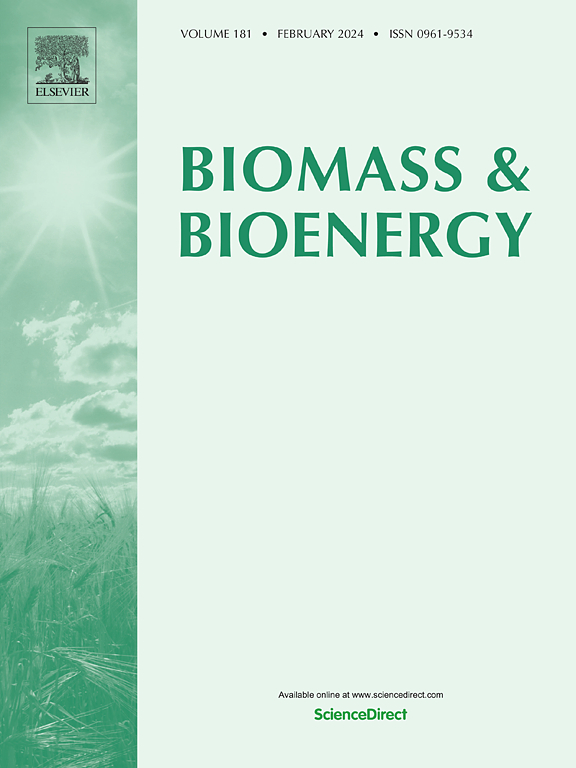巴西使用和管理甘蔗酒渣的不同方法:技术、经济和环境分析
IF 5.8
2区 生物学
Q1 AGRICULTURAL ENGINEERING
引用次数: 0
摘要
甘蔗乙醇生产产生各种残留物,其中酒糟是体积最大的。由于酒渣的有机物、钾和硫酸盐含量高,处理不当会对环境造成重大影响。厌氧生物消化和酒糟浓缩是有效管理酒糟和利用酒糟特性的有前途的技术。本研究比较了三种酒糟管理方法:自然应用、不同沼气用途的酒糟生物消化和酒糟浓度。为了提高环境准确性,考虑了天然酒液运输通道中的甲烷(CH₄)排放和生物消化过程中的逸散性排放这两个经常被忽视或低估的排放源。环境评估显示,虽然大多数方案的效果略好于自然方法,但生物消化方案有望带来更大的效益。然而,挥发性氯化氢的排放对结果有很大影响,因此需要监测和减轻这些损失,以经济和环境地推进技术。酒糟浓缩工艺成为一种可行的替代方案,在成本效益上排名第二,仅次于生物消化与柴油替代方案。这些发现强调了这种方法在平衡经济和环境效益方面的潜力,解释了它作为一种大规模战略越来越多地被采用。经济分析显示,与其他方案相比,生物消化与柴油替代方案的内部回报率略高,为15%。此外,敏感性分析表明,碳信用额的销售可以进一步提高经济绩效,贡献约6%的总收入。总的来说,该研究表明,将酒糟浓缩和生物消化作为可持续甘蔗乙醇生产的综合策略具有很大的潜力。本文章由计算机程序翻译,如有差异,请以英文原文为准。

Different approaches to sugarcane vinasse use and management in Brazil: A technical, economic, and environmental analysis
Sugarcane ethanol production generates various residues, with vinasse being the most voluminous. Due to its high organic matter, potassium, and sulfate content, improper disposal of vinasse can cause significant environmental impacts. Anaerobic biodigestion and vinasse concentration are promising technologies for managing vinasse effectively and harnessing its properties. This study compares three vinasse management approaches: in natura application, vinasse biodigestion with different biogas uses, and vinasse concentration. To enhance environmental accuracy, methane (CH₄) emissions from in natura vinasse transportation channels and fugitive emissions from the biodigestion process–two often overlooked or underestimated emission sources–were considered. Environmental assessments revealed that while most scenarios performed slightly better than the in natura approach, biodigestion scenarios were expected to deliver greater benefits. However, fugitive CH₄ emissions significantly influenced the results, highlighting the need to monitor and mitigate these losses to advance the technology economically and environmentally. The vinasse concentration process emerged as a viable alternative, ranking second in cost-effectiveness, just below biodigestion with diesel substitution scenario. These findings emphasize the potential of this approach to balance economic and environmental benefits, explaining its increasing adoption as a large-scale strategy. The economic analysis revealed that the biodigestion with diesel substitution scenario achieved a slightly higher internal rate of return of 15 % compared to the other scenarios. Additionally, the sensitivity analysis showed that carbon credits sales could further enhance economic performance, contributing approximately 6 % to total revenue. Overall, the study demonstrates the promising potential of vinasse concentration and biodigestion as integrated strategies for sustainable sugarcane ethanol production.
求助全文
通过发布文献求助,成功后即可免费获取论文全文。
去求助
来源期刊

Biomass & Bioenergy
工程技术-能源与燃料
CiteScore
11.50
自引率
3.30%
发文量
258
审稿时长
60 days
期刊介绍:
Biomass & Bioenergy is an international journal publishing original research papers and short communications, review articles and case studies on biological resources, chemical and biological processes, and biomass products for new renewable sources of energy and materials.
The scope of the journal extends to the environmental, management and economic aspects of biomass and bioenergy.
Key areas covered by the journal:
• Biomass: sources, energy crop production processes, genetic improvements, composition. Please note that research on these biomass subjects must be linked directly to bioenergy generation.
• Biological Residues: residues/rests from agricultural production, forestry and plantations (palm, sugar etc), processing industries, and municipal sources (MSW). Papers on the use of biomass residues through innovative processes/technological novelty and/or consideration of feedstock/system sustainability (or unsustainability) are welcomed. However waste treatment processes and pollution control or mitigation which are only tangentially related to bioenergy are not in the scope of the journal, as they are more suited to publications in the environmental arena. Papers that describe conventional waste streams (ie well described in existing literature) that do not empirically address ''new'' added value from the process are not suitable for submission to the journal.
• Bioenergy Processes: fermentations, thermochemical conversions, liquid and gaseous fuels, and petrochemical substitutes
• Bioenergy Utilization: direct combustion, gasification, electricity production, chemical processes, and by-product remediation
• Biomass and the Environment: carbon cycle, the net energy efficiency of bioenergy systems, assessment of sustainability, and biodiversity issues.
 求助内容:
求助内容: 应助结果提醒方式:
应助结果提醒方式:


